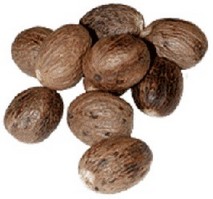SPICES - NUTMEG

Nutmeg is the seed of Myristica fragrans, an evergreen tree native to the Molucca Islands. Interestingly, the tree produces both Nutmeg and mace, and grows up to 60 feet tall. Both spices come from the tree’s fruit, which splits into a scarlet outer membrane, mace, and an inner brown seed, Nutmeg.
NUTMEG HISTORY
The Roman philosopher Pliny wrote about Nutmeg and mace in the first century. Indian Vedic literature recommended Nutmeg for bad breath, headaches, and fever. Arabian writing mentions its uses as an aphrodisiac and stomach medicine. Middle Eastern traders brought Nutmeg and mace to Southern Europe in the sixth century, and they were well known by the twelfth century from Italy to Denmark. The Portuguese found Nutmeg trees in the Molucca Islands, and dominated the Nutmeg and mace trade until the Dutch overcame it in 1602. Unaware that the spices came from one tree, one Dutch official ordered the Moluccan islanders to plant more mace trees, and fewer Nutmeg trees. Nutmeg production spread to the West Indies, Trinidad, and Grenada under the British in the 1800s.
USES
Nutmeg is a mild baking spice and is used in sausages, meats, soups, vegetables and preserves. Nutmeg is commonly added to eggnog, puddings, and fruit pies. It is popular all over the world, where it is used in vegetables, puddings, and stews.
Nutmeg and mace contain 7 to 14 percent essential oil, the principal components of which are pinene, camphene, and dipentene. Nutmeg on expression yields about 24 to 30 percent fixed oil called nutmeg butter, or oil of mace, the principal component of which is trimyristin. The oils are used as condiments and carminatives and to scent soaps and perfumes. An ointment of nutmeg butter has been used as a counter-irritant and in treatment of rheumatism.
